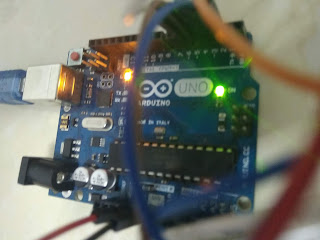Hello everyone!
Today I am going to present you, my Dual Axis Analog Joystick module and the components controlled by it. This Joystick module is used in many Arduino DIY projects and Robot control. In this project, I will be demonstrating you how the Joystick module can be used to control a variety of components. I have used two 5V single channel relay modules in this project. One module is connected to a Green LED and 1kΩ resistor. The LED and the resistor are powered by the Power Bank. I have not connected the Relay modules to AC power supply, Light bulb and Fan because AC power supply is something that should not be meddled with, and I do not want the Arduino beginners to be affected when carrying out this project.
Today I am going to present you, my Dual Axis Analog Joystick module and the components controlled by it. This Joystick module is used in many Arduino DIY projects and Robot control. In this project, I will be demonstrating you how the Joystick module can be used to control a variety of components. I have used two 5V single channel relay modules in this project. One module is connected to a Green LED and 1kΩ resistor. The LED and the resistor are powered by the Power Bank. I have not connected the Relay modules to AC power supply, Light bulb and Fan because AC power supply is something that should not be meddled with, and I do not want the Arduino beginners to be affected when carrying out this project.
* If anyone has decided to connect your relay modules with AC power supply, please take safety precautions.
Supplies
- Arduino Uno/ Nano
- USB Type A/B cable (for Arduino Uno) or USB Type A to mini B cable (for Arduino Nano)
- Solderless Breadboard - Mini
- Dual Axis XY Joystick module (KY-023)
- 5V single channel Relay module (x2)
- LED (x2) - Any colour ( I have used Blue and Green)
- Resistor - 1kΩ
- Active Buzzer module (KY-012)
- Male-to-Male Jumper wires (x9) - 10cm
- Female-to-Male Jumper wires (x6) - 20cm
- 3-pin Female-to-Female Jumper wires (x2) - 70cm
- Jumpers (x7) - Used to reduce the usage of jumper wires
Setup
Your setup must look somewhat familiar to the one from the image above. Please refer to the 'Connections' section and the YouTube video at the last section of this page for more details.
Connections
Dual Axis XY Joystick module (KY-023)
- GND - Ground (GND)
- +5V - 5V
- VRX - A0
- VRY - A1
- SW - D2
5V single channel Relay module
- (+) - 5V
- (-) - Ground (GND)
- S (Fan) - D4
- S (Light bulb) - D6
Active Buzzer module (KY-012)
- (+) - 5V
- (-) - Ground (GND)
- S - D5
LED
- Anode (+) - D3
- Cathode (-) - Ground (GND)
Coding
The SW pin of the Joystick module is the switch pin and it sends a signal to the microcontroller when the joystick is pressed. Prepare a sketch using the codes below and upload it onto your Arduino Uno/ Nano. Open the serial monitor and carefully record the values obtained when you move the Joystick upwards, downwards, towards the right and left. After obtaining nearly fifteen values for each movement, calculate a range within which these values fall. I have mentioned the argument within pinMode( ) of Switch pin as INPUT_PULLUP because the switch pin is similar to a push button and when you connect the push button to arduino without a pull-down resistor, you mention the argument within the pinMode( ) function as INPUT_PULLUP. This means that a LOW signal is sent to the microcontroller when the button is pressed and a HIGH signal is sent when it is released.
The codes were adapted from Brainy Bits. I have modified them a bit, so the codes look simple.
Create global variables for each components. Within the void setup( ) function, use the pinMode( ) function to configure each pin of the components as INPUT or OUTPUT.
Within the void loop( ) function, create local variables to store the state of each analog pin (X and Y) and another variable to store the state of the button (Switch pin). Use your calculated ranges and the 'if...else' function to decide which component must be switched on when the Joystick is moved.
- Upwards - Blue LED
- Downwards - Buzzer
- Right - Fan
- Left - Light bulb
The relays must be switched on when you move the joystick but must not be switched off when the position of the joystick is changed. For this purpose, you will only be using the if( ) function. When the Joystick is pressed, the relays must be switched off. Please watch the YouTube video to see how this works.
If you still have any doubts with the coding, please feel free to comment below or send an email to arduinoprojectsbyr@gmail.com.
Final Look
If you have any questions, or suggestions, about this project, please feel free to comment below or send an email to arduinoprojectsbyr@gmail.com.







Comments
Post a Comment